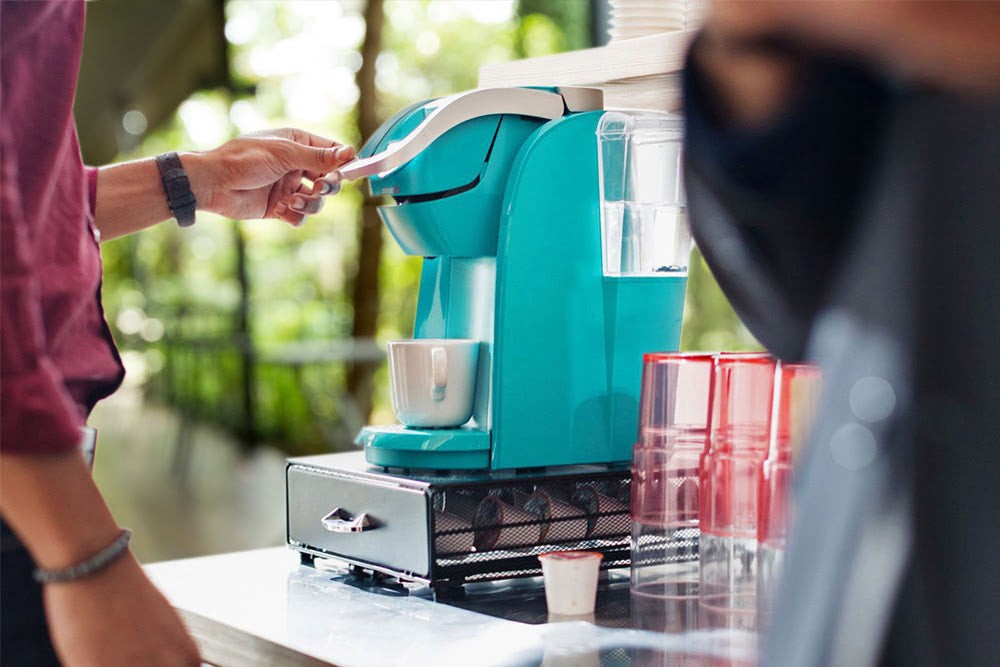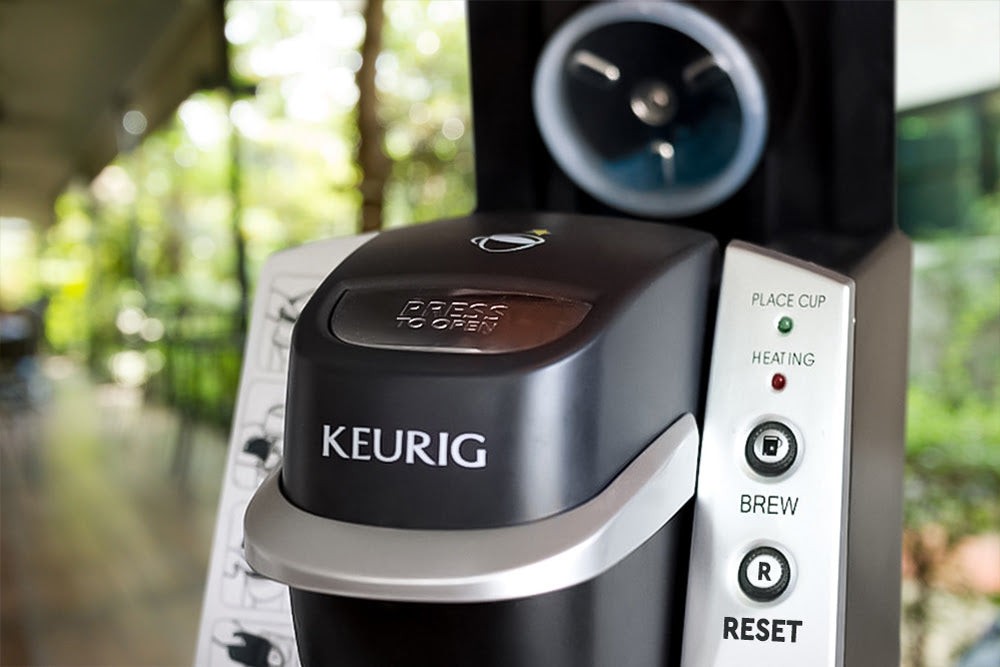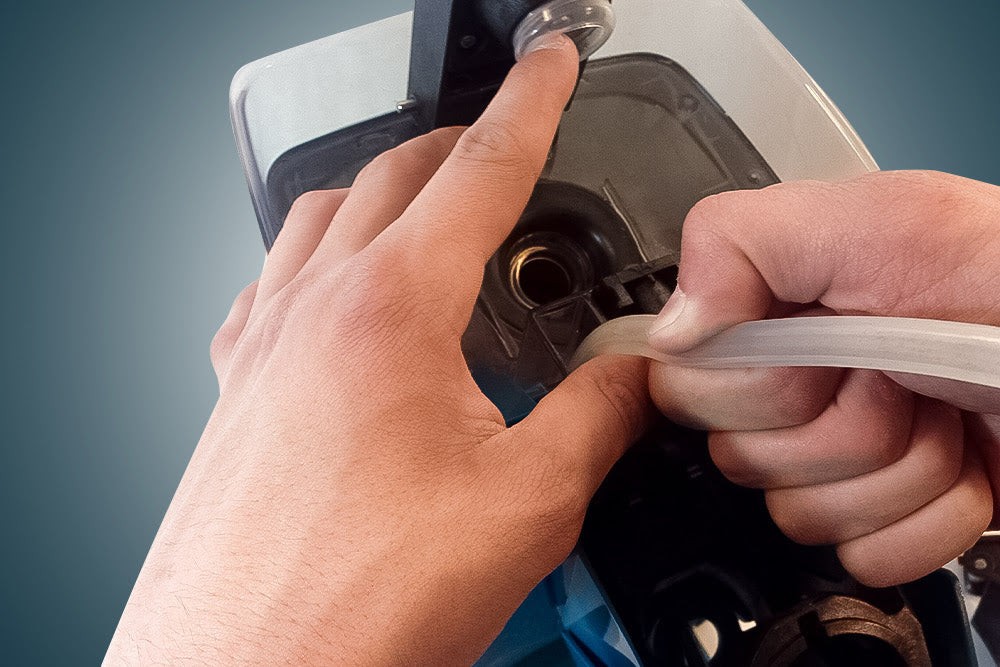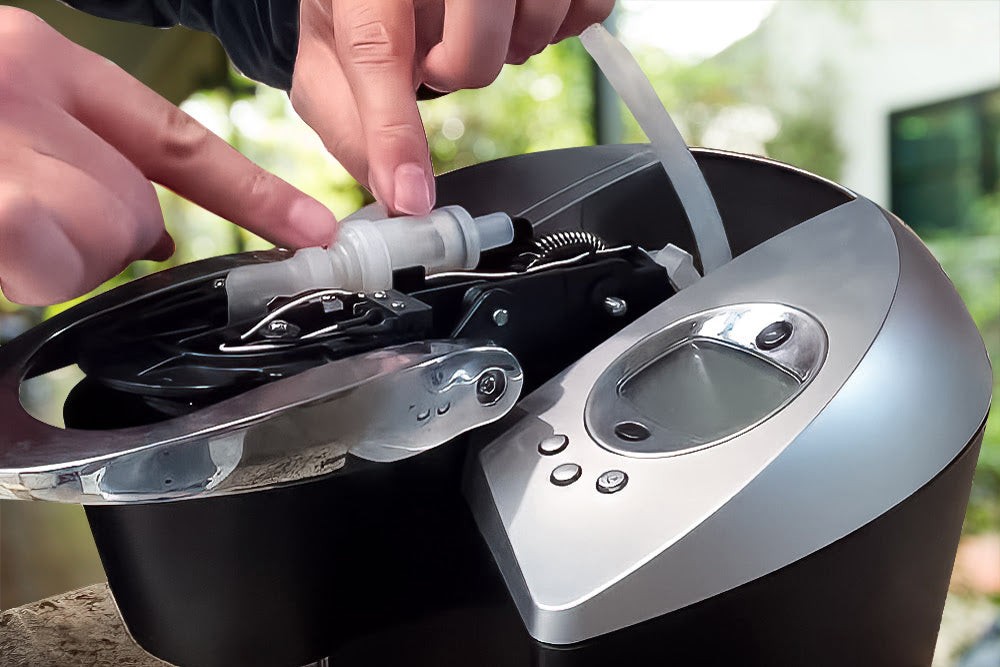Is your Keurig not working as it should? Discover the most common Keurig problems and simple solutions to get your coffee maker brewing again. At WHY.EDU.VN, we provide reliable answers and expert insights to keep your Keurig in top shape, ensuring you enjoy your daily cup of coffee without interruption. Learn about descaling issues, water pump problems, and other common malfunctions and find fast fixes, including replacement parts and cleaning tips.
1. Keurig Won’t Turn On: Potential Causes and Solutions
If your Keurig is unresponsive when you press the power button, several factors could be at play. Identifying the precise cause is key to resolving the issue efficiently.
Possible Causes:
- Incorrect Power Connection: The machine may not be correctly plugged into the power outlet.
- Malfunctioning Power Outlet: The power outlet itself may not be functioning correctly.
- Failure to Press the Power Button: You might not be pressing the power button directly or firmly enough.
Troubleshooting Steps:
- Check the Power Connection: Ensure the Keurig is securely plugged into a working power outlet. Unplug and re-plug to ensure a solid connection.
- Test the Power Outlet: Plug another device into the same outlet to verify it’s working. If the device doesn’t power on, the outlet may be faulty.
- Properly Press the Power Button: Make sure you are pressing the power button correctly. For Keurig 2.0s or Pluses, tap the power icon on the lower right corner of the LCD screen.
If the Keurig still doesn’t turn on after these steps, there might be an internal issue requiring professional repair.
2. Keurig Is Not Brewing: Addressing Common Brewing Problems
A Keurig that refuses to brew can be frustrating. This issue typically arises from air bubbles or debris obstructing the internal tubing. Here’s how to tackle it:
Common Causes:
- Air bubbles in the system
- Debris buildup in the tubing
- Misaligned components
Troubleshooting Steps:
- Flush the System: Run the Keurig without a K-cup to flush out any debris.
- Descale the Machine: Use a descaling solution, such as a mixture of white vinegar and water, to clear out mineral deposits.
- Check Component Alignment: Ensure the handle, water tank, K-cup holder, and lid are securely attached.
- Dislodge Air Bubbles: Fill the water reservoir to the maximum level, unplug the machine, and gently shake it to dislodge any trapped air bubbles.
If these steps don’t resolve the issue, the problem might be with the water pump or another internal component.
3. Keurig Coffee Tastes Bad: Improving Coffee Flavor
A poor-tasting cup of coffee from your Keurig can stem from several factors. Improving the taste often involves simple changes to your brewing routine.
Possible Causes:
- Infrequent cleaning
- Using tap water instead of filtered water
- Low-quality K-cups
- Mineral buildup
Solutions:
- Switch to Filtered Water: Using filtered water minimizes scale and coffee ground accumulation, which can negatively impact the taste.
- Try Different K-cups: Experiment with different K-cup brands and flavors to find one that suits your taste preferences.
- Descale Regularly: Follow the descaling process outlined in your Keurig’s manual. Descaling removes mineral deposits that can affect coffee flavor.
- Clean the Machine: Regularly clean the removable parts, such as the water reservoir and K-cup holder, to remove coffee residue.
Descaling Process:
| Step | Action |
|---|---|
| 1 | Empty the water reservoir and drip tray. |
| 2 | Remove the filter and any coffee pods. |
| 3 | Mix descaling solution and water in a 1:1 ratio and add it to the machine’s tank. |
| 4 | Run a descaling cycle according to your model’s instructions. |
| 5 | Run several cycles of water rinsing to remove any remaining descaling solution. |
4. Keurig Doesn’t Heat the Water: Addressing Heating Issues
If your Keurig is dispensing cold coffee, the heating system might be malfunctioning. This is often due to a damaged water pump or clogs caused by calcium and coffee ground buildup.
Possible Causes:
- Damaged water pump
- Calcium and coffee ground clogs
- Malfunctioning heating system
Troubleshooting Steps:
- Clean the Machine Thoroughly: Pay close attention to the bottom of the tank, including the valve and the area where the tank sits.
- Restart the Machine: Press and hold the brew button to initiate a restart.
- Check the Water Pump: If the water pump is damaged, contact Keurig support for a replacement.
The water pump is crucial for circulating water through the heating element, so its proper function is essential for hot coffee.
5. Keurig Is Leaking: Identifying and Fixing Leaks
A leaking Keurig can be caused by various issues, usually involving the water reservoir or internal components.
Types of Leaks and Causes:
- Leakage from the Bottom:
- Damaged or overfilled water reservoir
- Damaged O-ring
- Damaged internal water tank
- Leakage During Heating:
- Overfilled water reservoir
- Clogged machine
- Damaged upper gasket
- Accumulated coffee grounds or debris on the puncture needle
Solutions:
| Leak Type | Solution |
|---|---|
| Bottom Leak | Obtain a replacement part for the damaged component. Avoid overfilling the water reservoir. Ensure the water inside is cold. |
| Heating Process Leak | Ensure you do not exceed the maximum water line. Use a water and vinegar solution to descale the machine. Tighten or replace the gasket. |
6. Keurig Lights Are Blinking: Understanding Error Signals
Blinking lights on your Keurig indicate an issue that needs attention. The solution varies depending on the model.
Troubleshooting Steps by Model:
- Keurig Classic:
- Press the Add Water, Medium Cup, and Heat buttons simultaneously.
- Ensure the water reservoir is correctly positioned.
- Run a water-only brew of 6 or 8 ounces to check if the machine dispenses the correct amount of water.
- Change and reinsert the charcoal filter.
- Keurig Platinum:
- Turn off the machine.
- Press and hold the auto-off button.
- Press and hold the buttons for the available size options.
- Release all buttons once the lights stop blinking.
If the descale light remains illuminated after descaling, resetting your machine might help.
7. Keurig Dispenses an Excessive or Inadequate Amount of Coffee: Correcting Volume Issues
When your Keurig dispenses too much or too little coffee, adjustments are needed to restore the correct brewing volume.
Causes and Solutions:
- Excessive Dispensing:
- Clean the puncture needle using a paper clip.
- Unplug the machine and remove the water tank.
- Carefully turn the brewer upside down and gently tap the base to dislodge any debris.
- Reassemble the Keurig and run a cleansing brew cycle using only water.
- Inadequate Dispensing:
- Clean the entrance and exit needles.
- Run several water-only brew cycles to clear any clogs.
- Descale the machine to remove buildup in the water line.
8. Keurig Coffee Leaves Residue in the Cup: Preventing Grounds in Your Brew
Finding coffee grounds in your cup can be unpleasant. This issue often arises from using incorrect water types or a clogged exit needle.
Possible Causes:
- Using distilled or softened water
- Clogged exit needle
- Using a reusable filter with an incorrect grind size
Solutions:
- Switch to Bottled Water: Run a few cycles with only bottled water before inserting a new K-cup.
- Clean the Exit Needle: Ensure the exit needle is thoroughly cleaned and run multiple brews with water only.
- Use Correct Grind Size: Consult the instruction manual to confirm the correct grind size for your reusable filter. Coarsely ground coffee is generally recommended.
9. Keurig Shows “Add Water,” But It’s Full: Resolving Water Level Detection Problems
When your Keurig incorrectly indicates that the water reservoir is empty, it’s usually due to an improperly positioned reservoir, a clogged water filter, or a dirty machine.
Troubleshooting Steps:
- Reposition the Water Reservoir: Ensure its magnetic contacts align with those on your coffee maker.
- Clean the Filter and Reservoir:
- Use warm water with a few drops of dishwashing liquid to gently clean the filter.
- Wipe the reservoir with a damp cloth.
- Inspect the machine’s filter to ensure it’s clean and unclogged.
- Check and Clean the Valve: Ensure the valve beneath the machine is clean and unobstructed.
- Clean the Exit Needles: Clean the machine’s exit needles to ensure proper water flow.
10. Keurig Keeps Turning Off: Preventing Unexpected Shutdowns
If your Keurig turns off unexpectedly, it’s often due to the auto-off or energy-saving features. Understanding these settings can help prevent unwanted shutdowns.
Causes and Solutions:
- Auto-off Feature:
- Newer Keurig machines have an auto-off feature that turns off the machine after a period of inactivity.
- Disable the auto-off feature through the LCD menu or by pressing the Auto-off button.
- Magnet Misalignment:
- Ensure the magnets on your water tank are properly aligned. Misalignment can lead to unexpected shutdowns.
How to Reset a Keurig Machine: Step-by-Step Guide
Resetting your Keurig can resolve many common issues. The process varies depending on the model.
Resetting Newer Models:
- Navigate to the LCD menu and choose the factory reset option.
Resetting Older Models (K-Slim, K-Mini):
- Turn off and unplug your Keurig machine and remove the water tank.
- Leave it unplugged for a few minutes to a couple of hours, ensuring the reservoir is not attached.
- Plug your machine back in.
- Switch on your Keurig coffee maker and reattach the water reservoir, ensuring proper positioning.
Alternative Reset Method:
- Disconnect and reconnect your machine.
- Open and close the lid.
- Press and hold the power button.
- While holding the power button, simultaneously press the buttons for small, medium, and large cup sizes.
- The machine will automatically pump to prime itself.
How to Contact Keurig Support: Getting Professional Help
If troubleshooting steps don’t resolve your Keurig issues, contacting Keurig customer service is the next step.
Contact Options:
- Live Chat: For immediate assistance, connect with a Keurig representative through live chat on their website.
- Support Ticket: Submit a detailed ticket on their website explaining your problems. A customer representative will reach out to you via email.
Conclusion: Keeping Your Keurig in Top Condition
Troubleshooting your Keurig doesn’t have to be daunting. By following these tips, you can restore your machine’s functionality and continue enjoying your favorite beverages. Remember to maintain your machine with regular cleaning and descaling to prolong its lifespan.
If you’re still facing issues, don’t hesitate to seek expert advice. At WHY.EDU.VN, we’re dedicated to providing comprehensive solutions and reliable information to help you keep your Keurig running smoothly.
Facing persistent issues with your Keurig or have a burning question about coffee maker maintenance? Don’t hesitate to reach out to the experts at WHY.EDU.VN. Visit our website at why.edu.vn to ask your question and receive detailed, expert answers tailored to your specific needs. You can also reach us at our address: 101 Curiosity Lane, Answer Town, CA 90210, United States, or via WhatsApp at +1 (213) 555-0101. Let us help you keep your Keurig in perfect working order!
Frequently Asked Questions: Addressing Common Concerns
1. What should I do if my Keurig won’t turn on?
First, ensure the machine is properly plugged in and securely connected to a power source. After that, try disconnecting and reconnecting your machine. If all else fails, press and hold the power button while simultaneously pressing the buttons for small, medium, and large cup sizes – this should reset your machine. If it still doesn’t turn on, contact Keurig customer service for further assistance.
2. How do I descale my Keurig?
Descaling is essential to any coffee machine’s maintenance and will ensure your Keurig maintains its performance over time. Generally, you must fill a reservoir with a descaling solution and let it run through the machine several times.
3. Is there an alternative way to contact Keurig customer support?
Yes! If you need help quickly, you can connect with a Keurig representative through live chat. Alternatively, you can also find help within the Keurig community forums, where several experienced users have likely already had and solved your problem.
4. How do I know when to replace my Keurig?
If you’re experiencing issues that require frequent repairs or if you find yourself spending more time troubleshooting than enjoying your coffee, it may be time to invest in a new machine.
5. How often should I clean my Keurig?
To keep your Keurig brewing delicious coffee, it’s important to clean it regularly. Depending on your model, this may mean wiping down surfaces and descaling periodically. You should refer to the user manual for specific instructions regarding your machine.
6. What other things can I do to help my Keurig last longer?
Keeping up with regular maintenance, such as descaling and cleaning, is key for ensuring the longevity of your machine. Additionally, you should always use fresh coffee grounds to get the best-tasting brews.
7. What if I find that the water reservoir isn’t working?
If the water reservoir isn’t working, it could be due to several things. Ensure all connections are secure and check for any obstructions in the line leading from the reservoir to the machine. If this doesn’t solve the issue, you may need to replace the water reservoir.
8. Why is my Keurig brewing weak coffee?
Weak coffee from your Keurig can be due to several reasons:
- Weak K-Cup: Try using a stronger K-Cup or a different brand.
- Water to Coffee Ratio: Ensure you are using the correct water level for the K-Cup.
- Clogged Needle: Clean the entrance and exit needles to ensure proper water flow.
- Descaling Needed: Mineral buildup can affect the brewing process. Descale your Keurig regularly.
9. My Keurig is making a loud noise; what could it be?
Loud noises from your Keurig often indicate air trapped in the system or a blockage. Here’s how to troubleshoot:
- Air Bubbles: Unplug the machine and gently shake it to dislodge air bubbles.
- Clogged Needle: Clean the entrance and exit needles to remove any blockages.
- Descaling: Mineral buildup can cause noisy operation. Descale your Keurig.
- Water Pump: If the noise persists, the water pump might be failing. Contact Keurig support.
10. Can I use tap water in my Keurig?
While you can use tap water in your Keurig, it is not recommended. Tap water often contains minerals and chemicals that can affect the taste of your coffee and cause mineral buildup in the machine. Using filtered water is always best for both the taste of your coffee and the longevity of your Keurig.





